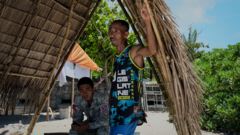The Philippines-controlled Pagasa Island, also known as Thitu, has emerged as an unexpected frontline in the ongoing territorial disputes in the South China Sea. With a mere 37 hectares to its name, the island is home to about 300 resilient inhabitants who embody the spirit of perseverance against looming Chinese maritime presence. Situated in waters asserted by China, the island has relied heavily on fishing and agriculture, although Chinese coastguard ships increasingly intimidate local fishermen.
China’s assertiveness over the past decade has involved extensive reclamation and militarization of reef structures, from which it has built air bases and deployed large fleets of military and maritime vessels. In stark contrast, Southeast Asian nations like the Philippines have historically restrained their responses due to the imbalance in military capabilities. Yet, Pagasa Island remains a significant part of the Philippines’ strategy, with officials emphasizing its residential community and solid land status as grounding for legal claims.
“Pagasa is vital to us,” insists Jonathan Malaya of the Philippines National Security Council, underscoring the island's airstrip, population, and self-sufficiency as defense against potential territorial threats.
Transport to and from Pagasa can be precarious, often requiring a days-long boat journey or a short but unreliable flight due to unpredictable weather. Recent infrastructure improvements, such as an expanded runway and new hangar facilities, are part of the Philippines' efforts to bolster its presence here, aiming for both security and stability for the residents.
The challenges are palpable, especially for local fishermen like Larry Hugo, who face increasingly aggressive encounters with Chinese vessels. "They really scare us,” he shared, explaining how such experiences have forced him to limit his fishery activities.
Despite these pressures, the island thrives with a burgeoning community spirit. Educator Realyn Limbo describes the serene life on Pagasa, where the simplicity of community goes hand-in-hand with the challenges of isolation. Local healthcare worker Melania Alojado reflects on the joys and difficulties of island life, highlighting resource constraints but also pointing out the tranquility and social support available.
Pagasa Island might seem like a quiet paradise, but the undertones of military readiness are ever-present as the Philippine government diplomatically protests against the Chinese presence. Malaya notes the shift in government stance towards a more assertive position in recent times, reaffirming hopes to stand firm against threats while pursuing rightful claims in the region.
As geopolitical tensions surge in the South China Sea, the determination of Pagasa Island’s inhabitants serves as a poignant reminder of the human side of these intricate territorial disputes and invites a conversation on sustainable livelihoods amidst adversity.


















